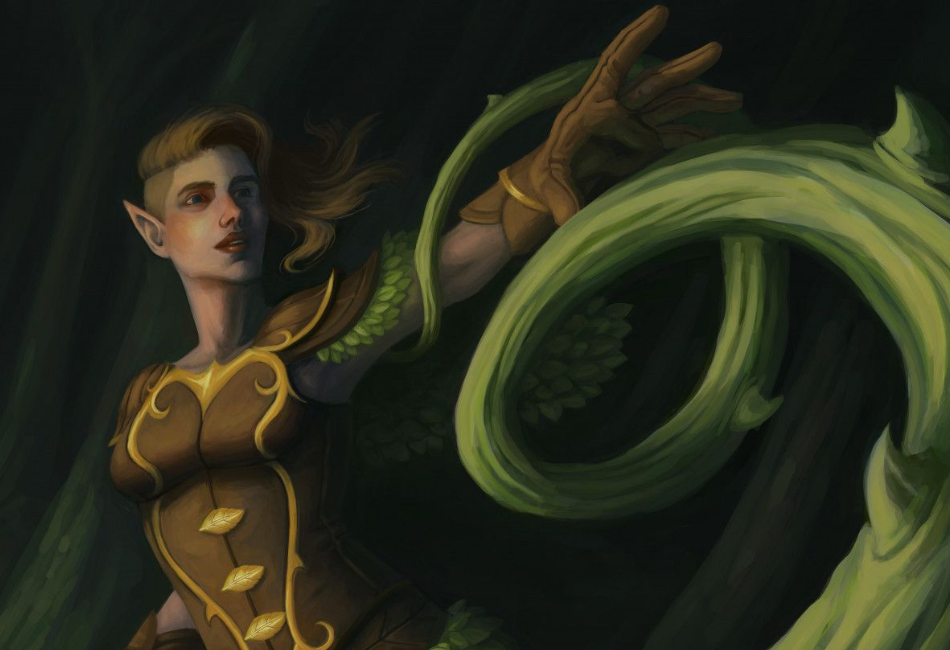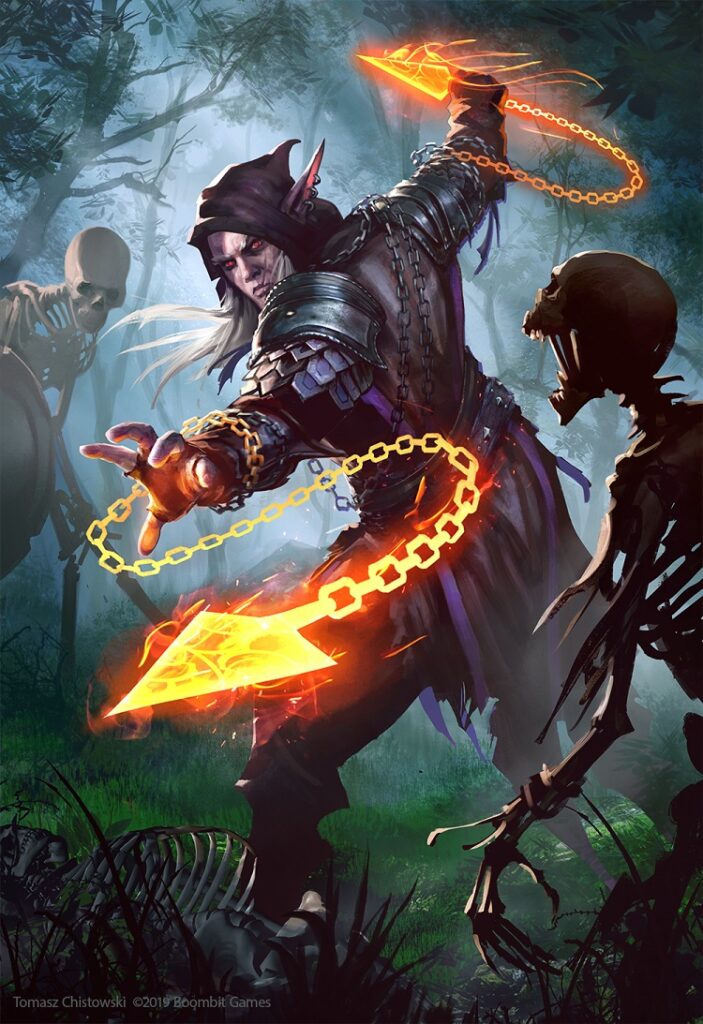The grasping vines seemed to be crushing the life out of the lycanthrope’s legs. Finally, the wererat had broken free. Safety! Freedom!
Just as it was about to turn and run, it could hear an angry voice in the distance,
“Get over here!”
Oh, no!
Suddenly a thorny vine grasped the wererat’s body and it could feel itself being dragged back into the entanglement from which it had so recently been freed.
Thorn Whip 5e Guide: Bottomline
Thorn Whip is a melee cantrip with a range of 30 feet. It allows you to move an enemy 10 feet towards you and does 1d6 magical piercing damage.
How Does Thorn Whip Work?
A long, vine-like whip covered in thorns appears. You can use the whip to attack any creature within a 30-foot range, as a melee spell attack. Creatures hit take magical piercing damage. If the creature is Large or smaller, you pull the creature 10 feet closer to you. Here are its stats:
- Thorn Whip
- Transmutation cantrip
- Casting Time: 1 action
- Range: 30 feet
- Components: V, S, M (the stem of a plant with thorns)
- Duration: Instantaneous
How Does Thorn Whip Scale?
The damage increases by 1d6 when you reach various levels. Total damage at each milestone:
- 5th level: 2d6
- 11th level: 3d6
- 17th level: 4d6
Who Can Use Thorn Whip?
As per Player’s Handbook (PHB) rules, only the Druid class. Tasha’s Cauldron of Everything allows for Artificers.
Is Thorn Whip Good?
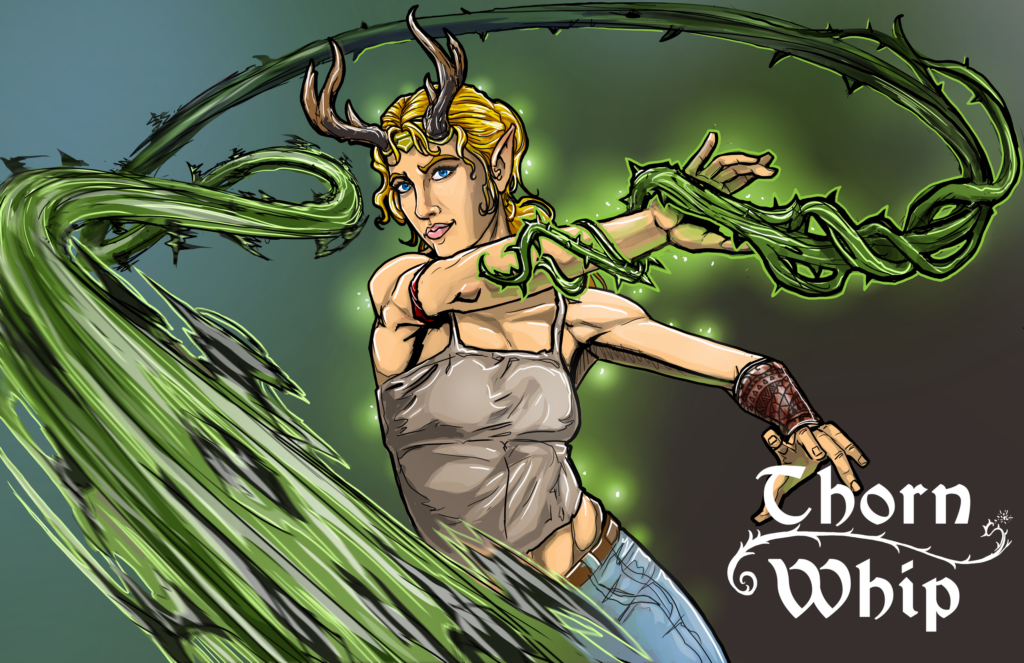
Yes. It can be very good in the right circumstance.
The question is, is it worth giving up other cantrips?
RAW (rules as written), you’re basically stuck with the cantrips until the day your character dies, although many DMs will homebrew some type of option, like exchanging cantrips when you level up.
Even Wizards of the Coast PHB rules designer Jeremy Crawford has reigned in on this issue via Twitter:
“Learning a cantrip is typically permanent. A DM could come up with a story-based way to replace one w/ another.”
Therefore, if your DM has a RAW/Crawford policy on cantrips, you’d better be very careful before you choose.
If you’re playing by PHB rules and you’re considering Thorn Whip, you’re playing a druid.
When you create your druid, you start out with 2 cantrips and that’s all you get until you hit level 4.
Within PHB, you can choose 2 cantrips, including Thorn Whip, from the following list of 8:
- Druidcraft
- Guidance
- Mending
- Poison Spray
- Produce Flame
- Resistance
- Shillelagh
- Thorn Whip
When you’re making such an important decision for your character, most experienced players I’ve heard would suggest that you pick the 2 cantrips that would be useful in the most possible situations.
My advice, especially when it comes to cantrips, is to cross the situation-dependent options off the list in favor of universally applicable ones.
Thorn Whip
At 1st level, I’m more concerned about pushing opponents away from me, not towards me.
Why?
- If monsters attack my party, getting them to come towards us won’t require a spell.
- 1st level druids aren’t nearly as squishy as sorcerers and wizards, but they’re not made for fighting close. The whole point of having tanks in the party is so that casters don’t have to get close to monsters in a fight.
- Most dangerous AOE spells, like Cloud of Daggers, work better with push spells than they do with pull spells like Thorn Whip in my opinion. The reason is that dangerous AOE spells work best in narrow choke points. If I push somebody through a Cloud of Daggers positioned at a narrow choke point, they can’t attack me without running back into the AOE and taking more damage. If I pull them into a dangerous AOE, once they take the damage and come out the other side, I’m in their path and vulnerable to attack.
At higher levels, Thorn Whip can be very useful. Here is an example from Critical Role.
Critical Role

For those who don’t know, Critical Role is a platform that streams 5e campaigns and is the origin of Amazon Prime’s animated series The Legend of Vox Machina. Their DM, Matt Mercer, has streamed one-shots with celebrities like Vin Diesel, Terry Crews, and Stephen Colbert.
I used to be a skeptic of Thorn Whip for reasons I’ll go into in the Pros and Cons section. However, an episode of Critical Role has changed my opinion.
During one of Critical Role’s campaigns, a party of adventurers found themselves in the Underdark battling 4 black puddings. Experienced gamers know that black puddings can be very dangerous if attacked with the wrong damage type.
The reason why they had 4 black puddings instead of 1 is that the party used lightning attacks and the creature divided itself. Whenever anyone scored a melee attack on the creature, that party member would take acid damage.
It just so happened that they were near some lava flows during the fight. The party’s 9th-level Circle of the Moon druid managed to use Thorn Whip on 2 of the puddings. Her ability to Wildshape into a giant eagle as a bonus action helped her get into the right position within the battlespace to pull that trick off.
For a cantrip to be used so successfully during high-level play, during a high-profile game, was interesting to see. Obviously, a normal lasso would just get dissolved in acid.
But, the magical nature of Thorn Whip apparently works on amorphous creatures: black puddings, gray oozes, ochre jellies, green slimes, etc. For that reason, I think it’s good to have for high-level play.
For my druids, I would probably pass at 1st level and then take Thorn Whip at 4th level. However, I could understand why other players would want to pass on Druidcraft and choose Thorn Whip instead. It’s all about your style of play.
Pros and Cons
| Pros | Cons |
| Pulling power 10 feet | No pushing |
| Melee for up to 30 feet | Limited range, 30 feet |
| Magical Piercing damage | Only 1d6 damage |
| Not saving throw | Creatures not structures |
| Works on Large or smaller, regardless of Strength | |
| Works on amorphous | |
| Scalable |
Thornwhip Applications
Before writing this article, I had no idea how versatile Thorn Whip could be.
Thorn Whip and Lycanthropes
One important selling point of Thorn Whip is its use as magical damage for creatures that have Immunity to non-magical piercing/slashing/bludgeoning damage.
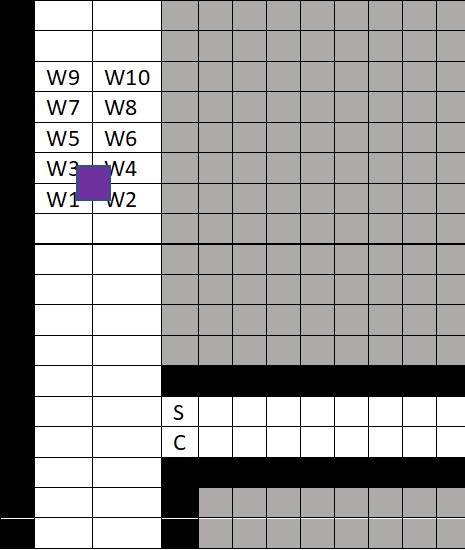
In my Cloud of Daggers 5e Guide, I ran a scenario for the spell. A 3rd-level warlock had cast Cloud of Daggers on a pack of 10 wererats. She needed a 3rd-level druid to cast Entangle to contain the wererats within the AOE.
Each grid is 5 feet. Each wererat is marked with a W + number. The casters are marked with an S and a C for Semiramis and Conchobar. The purple square represents the Cloud of Daggers.
As the fight progressed, some of the wererats passed their Strength checks and were able to break free of the Entangle Spell and leave the Cloud of Daggers AOE to attack the 2 casters.
The druid and the warlock were waiting for the escapees with push spells, Thunderwave and Repellant Blast respectively, to push the charging wererats back into the Cloud of Daggers AOE for additional damage.
This worked very well for the drow warlock Semiramis because Repellant Blast is an Invocation of the cantrip Eldritch Blast, so she could attack that way all day long. For the Circle of the Moon druid Conchobar there was a problem. If you look at his spell list and equipment, you’ll see why:
| Cantrips (2) +1 | Druidcraft, Guidance, |
| 1st level (4) +1 | Animal Friendship, Entangle, Speak With Animals, Thunderwave |
| 2nd level (2) +2 | Beast Sense, Moonbeam |
| Lvl | AC | HP | Move | Weapon | Equipment |
| 3 | 17 | 27 | 30 | Silver Dagger +5/+3 Dam 1d4+3 (4-7) | Studded leather, Rapier, Wooden Shield, Silver Dagger, Sling |
Notice that Conchobar has 3 combat spells: Entangle, Thunderwave, and Moonbeam. He cast Entangle to trap the wererats within the Cloud of Daggers AOE. He cast Thunderwave to push them back into the AOE, using that spell slot.
He couldn’t cast Moonbeam because it is a concentration spell. Doing so would have ended his Entangle Spell and freed the wererats.
Conchobar actually has a 16 Dexterity, so he could have done a lot of damage with his sling. The only problem is that the ammunition for his sling is not magical. Wererats have Immunity to non-magical piercing/slashing/bludgeoning damage, making the druid’s ammunition useless in this particular fight.
Conchobar does have a silver dagger. He could have. of course, hugged the walls to squeeze past the Cloud of Daggers without taking damage. Then he could have engaged the wererats in melee with his silver dagger.
That would have exposed him to unnecessary risk, however. Furthermore, if he had been wounded, he would have had to roll a Constitution check. If he had failed the check, his concentration spell Entangle would have ended and the wererats would have been free to attack the 2 casters all at once.
Preventing the 10 wererats from attacking all at once was key to the casters’ Defeat in Detail strategy. Maintaining the Entangle Spell ensured that the casters would never have had to fight more than a couple of wererats at the same time.
Conchobar also had the option of throwing his silver dagger as a ranged attack, but that would have cost him his only melee weapon that would be capable of damaging his lycanthrope foes.
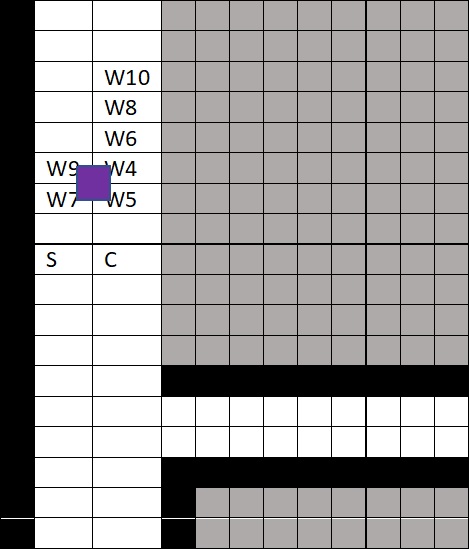
During the battle with the wererats in the sewers of Calimport, Conchobar had cast his Thunderwave Spell in Round 3. By the beginning of Round 4, he had effectively used all of his combat spells.
He still had Moonbeam, but casting that concentration spell would have ended the Entangle and set several wererats free. (Also, by the beginning of Round 4, positions had changed and W1, W2, and W3 had been killed and cleared from the grid.)
All the druid could do during Round 4 and the rest of the battle was to draw his silver dagger and take the Ready action to defend against any charging wererats that might break free of the Entangle Spell.
Meanwhile, his drow warlock companion was able to cast Shatter Spell for Round 4 and use Eldritch Blast to finish off any remaining lycanthropes for the remaining rounds.
How would Thorn Whip have changed this?
Conchobar could have used Thorn Whip in many ways.
By Round 4, Conchobar would have been about 5 feet in front of the Cloud of Daggers. During Round 4, the wererat marked as W10 broke free and ran away. Conchobar could have used Thorn Whip to pull 10 back into the AOE of the Entangle Spell and re-trap the wererat.
By Round 5, all of the wererats were dead or doomed with the exception of W6 and W8, who were still trapped in the Entangle Spell and had each lost half their hit points. Based on the battlemap, W6 was trapped 2 ½ feet from the Cloud of Daggers AOE.
Could Thorn Whip be used to pull a trapped creature a short distance without freeing that creature from the trap? Depending on the DM, I would say yes.
W6 had its legs anchored to the floor with the vines of the Entangle Spell. Many DMs would allow Conchobar to use Thorn Whip to pull some part of W6’s upper body, an arm or the head, a short distance of 2 ½ feet into the AOE of the Cloud of Daggers to take 4d4 magical slashing damage/round.
Since W6 had already lost half its hit points by Round 5, it would have been dead after 1-2 rounds of damage, definitely by the end of Round 6.
That would have left only 2 surviving lycanthropes, W8 and W10. By the beginning of Round 7, W8 would have been killed off by the drow warlock’s Eldritch Blast. Had W10 managed to escape again, Conchobar could have pulled it back into his Entangle Spell again, which would have had about 4 rounds left on its duration.
Conchobar could have used his Thorn Whip to deal 1d6 magical piercing damage to help Semiramis finish off the surviving wererat. If they thought they were running out of time, Conchobar could have ended his Entangle Spell and pulled W10 into the Cloud of Daggers, which was also scheduled to end by Round 10.
If after Conchobar had ended his Entangle Spell, W10 were to escape the cloud and run, he could have used Thorn Whip to pull W10 back into the cloud a second time for additional damage.
If the W10, were to escape the cloud and attack the casters, Conchobar would have been waiting for it with his silver dagger. Semiramis is a Pact of the Blade warlock, so her rapier is magical for purposes of hitting creatures with weapon immunities.
This also would have been a chance for Conchobar to try the Offhand Attack Option below, if the DM allows it.
Offhand Attack Option
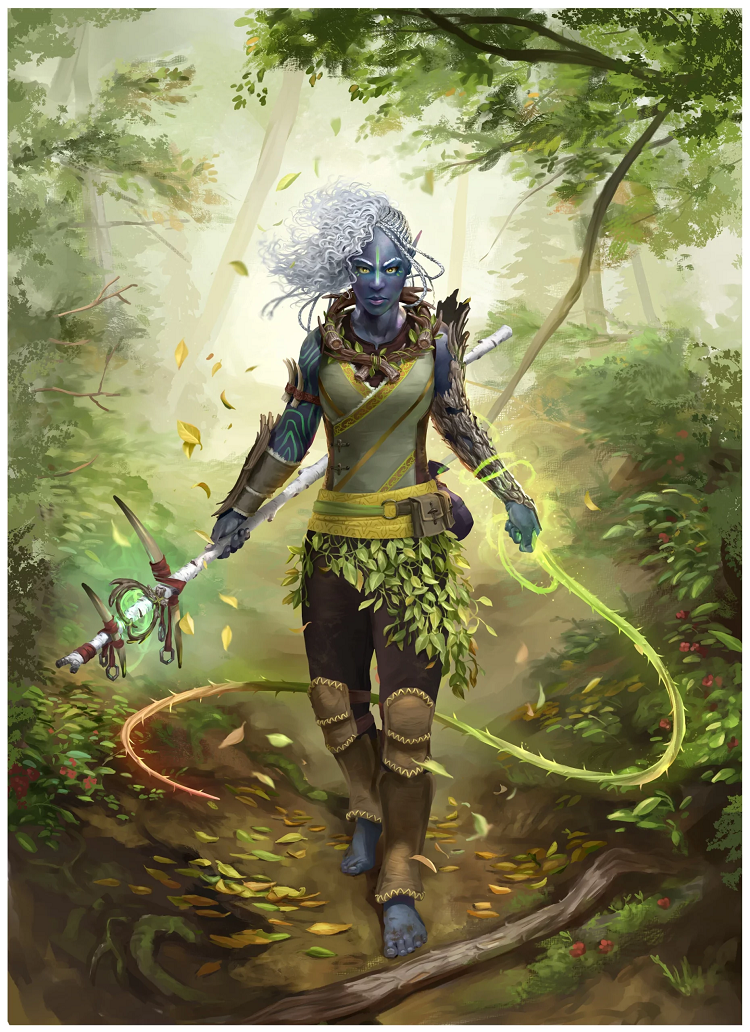
This is a grey area and your DM might not allow it.
On PHB p. 195, Two-Weapon Fighting is discussed:
- You have to be holding 1 light weapon in each hand.
- You can attack with your Off-Hand (the hand you don’t normally fight with) as a bonus action without attack and damage modifiers.
- If either weapon has a thrown property, you can throw the weapon instead of making a melee attack.
Technically, like a rapier, a whip is a finesse weapon, not a light weapon. Therefore, it cannot be used for the Two-Weapon Fighting Bonus Action.
In my Off-Hand Attack 5e Guide, I critique this rule against finesse weapons for Bonus Action Two-Weapon Fighting and cite Florentine fencing (rapier and dagger/main gauche) as an example.
I also discuss the possibility of a homebrew rule that allows characters to use finesse weapons that are not light for Two-Weapon Fighting provided that the Off-Hand Weapon is light. Therefore, a character could fight with a whip or rapier in the dominant hand and a light weapon, like a dagger, in the Off-Hand.
In Conchobar’s case, he would be able to attack with his Thorn Whip using his dominant hand, his right, for casting and using his Off-Hand, his left, for his silver dagger.
This is a grey area because druids aren’t proficient with whips and the Thorn Whip user isn’t getting any ability modifiers to damage. Thus, they aren’t making an attack with a whip but rather they are “executing a melee attack with a spell”.
Therefore, some DMs may not allow for my proposed homebrew. However, a lot of DMs like to see good role-play, and finding different ways to use a spell is an important part of good role-play. It’s hard to believe that an extra 1d4 or 1d6 as a bonus action on a spell attack would be viewed as overpowered.
Thorn Whip on Allies
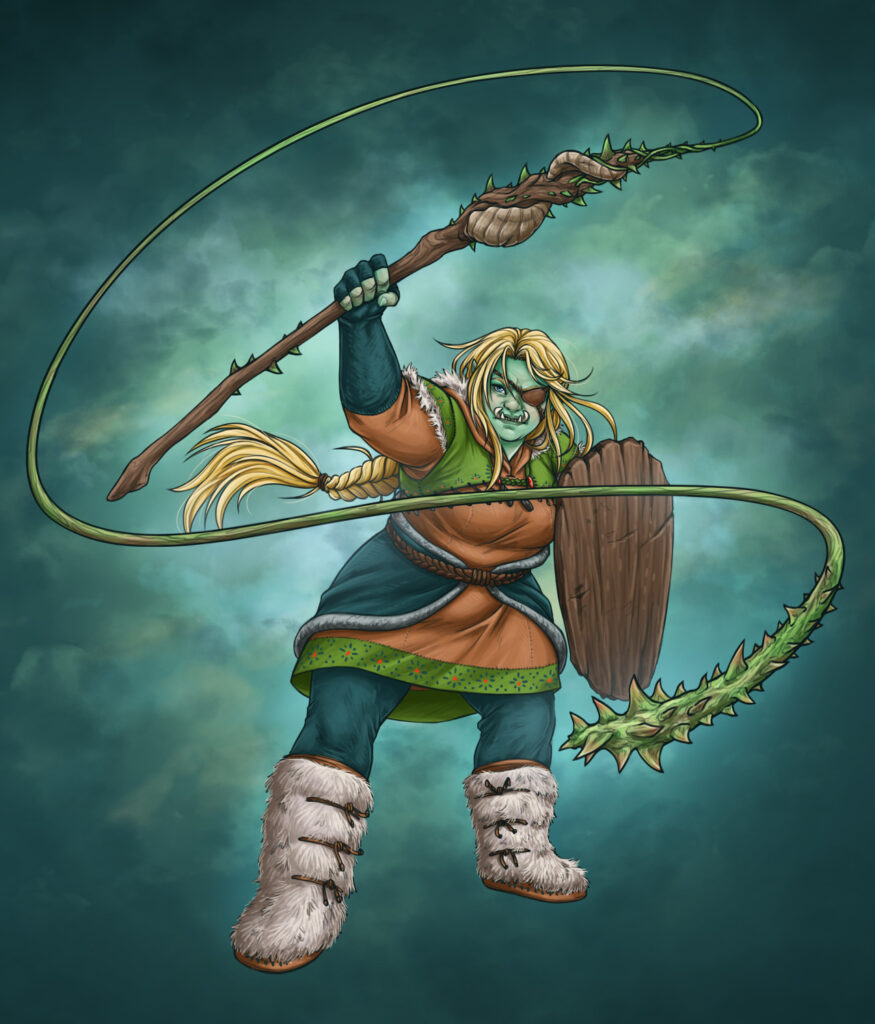
Don’t damage your friends!
Why would you do that?
Thorn Whip can be used to evacuate companions and allies from melee combat with powerful opponents. Depending on whom your friend is fighting, taking 1d6 damage can be a small price to pay for avoiding an enemy’s opportunity attack. Example:
The party’s tank, a female half-orc barbarian named Baggi, is using her action to make a melee attack on a shadow demon. The party’s sorcerer wants to lay some pain on the enemy without catching Baggi in the crossfire but if Baggi uses her movement to escape, she will be open to some vicious opportunity attacks.
Conchobar has been waiting with the Ready action for Baggi to make her attack. After she attacks but before her turn is over, Conchobar attacks Baggi, his own companion, with Thornwhip.
Conchobar does 1d6 damage to Baggi and pulls her back 10 feet. This puts her out of reach of the shadow demon’s claws without Baggi using her own movement. Therefore, there is no opportunity attack.
Furthermore, because Conchobar has timed his attack to be within the middle of Baggi’s turn, Baggi still has her movement left. With 10 feet of distance between her and the shadow demon, she uses her 30 feet of movement to move back 20 feet towards Conchobar, who is 30 feet away from the shadow demon because of the long reach of Thorn Whip.
Now the sorcerer, who is also 30 feet away, can start blasting away with whatever without fear of catching any friendlies in the spell’s AOE.
Thorn Whip Opportunity Attacks
Because of Thorn Whip’s reach, it is a great way to pin down an enemy with an opportunity attack. Conchobar can attack any enemy he wants from 6 squares away. Wherever that enemy is, that enemy can’t leave that long reach unless he wants to give Conchobar a free attack.
At 3rd level, a free 1d6 damage is nothing, but we know that this cantrip scales upwards. Let’s say Conchobar is 5th level. He attacks the shadow demon above with Thorn Whip and does 2d6 damage.
If the shadow moves toward Conchobar to attack him, there is no opportunity attack. Let’s say, however, that the shadow demon does not want to attack Conchobar because it considers the sorcerer standing on the opposite end of the battlefield to be a bigger threat.
Once the shadow demon leaves Conchobar’s 30-foot reach to attack the sorcerer, Conchobar will get an opportunity attack the demon for another 2d6 damage.
That’s without the Sentinel feat.
If Conchobar at 4th level decides to pass on the ASIs in order to buy the Sentinel feat, the druid’s opportunity attack would reduce the shadow demon’s movement to 0.
Furthermore, if Conchobar has the Sentinel feat, the sorcerer doesn’t even need to be standing on the other side of the battlespace to provoke an opportunity attack. Anywhere within 5 feet of Conchobar will do. Example:
Conchobar, at 5th level, is standing 30 feet away from the shadow demon and the sorcerer is standing 5 feet away from Conchobar. Conchobar attacks the shadow demon for 2d6 damage. (The shadow demon is resistant to non-magical piercing/slashing/bludgeoning damage, but Thorn Whip is magical piercing damage.)
The shadow demon attacks the sorcerer, who has recently angered the shadow demon with a damage-dealing spell. This provokes an opportunity attack from Conchobar’s Thorn Whip due to the Sentinel feat. The Thorn Whip does another 2d6 damage and reduces the shadow movement to 0.
Now the other party members, the sorcerer and the barbarian, get free attacks on the shadow demon. As long as they make their attacks from a distance of greater than 5 feet, the shadow demon can’t counter-attack until its next turn. If it attacks any party member other than Conchobar, he can do the same trick all over again.
Thorn Whip Gallows
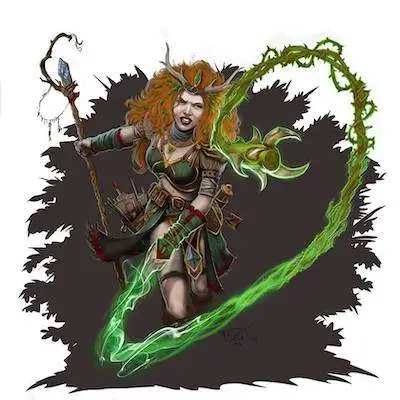
This is for sadistic druids and your DM may not allow it.
Does your DM allow targeted attacks? Let’s say your DM allows you to target a body part by rolling at a disadvantage. (That’s how they do it on Critical Role.)
If that rule is in play, here is an example of how a Thorn Whip gallows works:
Conchobar is standing on a balcony 20 feet above the level below. On the level below is wererat. Conchobar makes a targeted attack on the wererat’s neck for magical piercing damage and pulls the enemy 10 feet towards him.
Because Conchobar is standing on a balcony on the level above, 10 feet towards him is straight up. The wererat is effectively being lynched.
The DM can decide what the rules are for hanging:
- Suffocation PHB p. 183
Since Thorn Whip is a cantrip, one could argue that rope can be maintained each round by the caster simply casting the same cantrip again and again. Some DMs, however, might not allow that.
Instead, the rope would disappear before it could be reformed and the target would take 1d6 falling damage. In the next round, the caster would have to roll to hit all over again. I as a DM, however, would allow for a Thorn Whip gallows.
If Conchobar wants to really get into sadistic role-play, he can conduct a mock trial while hanging his victim,
“As the honorable Judge Conchobar, determine that this court finds you guilty of despicable villainy and hereby sentence you to hang from the neck until dead.”
FAQs
Question: Does Thorn Whip Work Against Structures?
Answer: RAW, no. You cannot do an Indiana Jones with Thorn Whip and swing across pits unless your DM wants to homebrew your cantrip. PHB p. 282, “lashes out at your command toward a creature within range”.
Question: Is Thorn Whip Damage Magical or Non-magical?
Answer: According to Sage Advice, it’s magical.
Question: If I Choose, Can I Pull Less than 10 feet? (i.e., 5 feet, 2 feet, etc.)
Answer: Yes. PHB p. 282, “up to 10 feet”.
Conclusion
Thorn Whip is a scalable melee attack cantrip with a range of 30 feet. A hit does 1d6 piercing damage and allows you to pull the target 10 feet toward you.
I’ll admit, before writing this article I didn’t truly comprehend Thorn Whip’s true value and versatility. Were I to choose again, I would consider choosing Thorn Whip over Druidcraft. Its reach, scalability, and versatility make it about as good a combat cantrip as a druid is going to get, at least within PHB rules.
- Perform Bewitching 5e Guide - October 1, 2022
- Inspiring Leader 5e Guide - September 20, 2022
- Scrying 5e Guide - September 19, 2022

